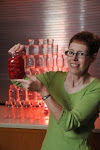Foodborne illnesses do increase during the summer, and the answer appears to be twofold. First, there are the natural causes. Bacteria are present throughout the environment in soil, air, water, and in the bodies of people and animals. These microorganisms grow faster in the warm summer months. Most foodborne bacteria grow fastest at temperatures from 90 to 110 °F.
Given the right circumstances, harmful bacteria can quickly multiply on food to large numbers. When this happens, someone eating the food can get sick.
Second, there are the "people" causes for the upswing in summertime foodborne illnesses. Outside activities increase. More people are cooking outside at picnics, barbecues, and on camping trips.
Foodborne illness increases in warm weather. Consumers can Fight BAC!® by following these simple steps to safer food in the summertime.
Clean: Wash Hands and Surfaces Often.
Unwashed hands are a prime cause of foodborne illness.
• Wash your hands with warm, soapy water before handling food and after using the bathroom, changing diapers, and handling pets.
• When eating away from home, find out if there's a source of potable (safe drinking) water. If not, bring water for preparation and cleaning. Or pack clean, wet, disposable washcloths or moist towelettes and paper towels for cleaning hands and surfaces.
Separate: Don't Cross-Contaminate.
Cross-contamination during preparation, grilling, and serving food is a prime cause of foodborne illness.
• When packing the cooler chest for an outing, wrap raw meats securely; avoid raw meat juices from coming in contact with ready-to-eat food.
• Wash plates, utensils, and cutting boards that held the raw meat or poultry before using again for cooked food. Cook: Cook to Proper Temperatures.
Food safety experts agree that food is safely cooked when it is heated for a long enough time and at a high enough temperature to kill harmful bacteria that cause foodborne illness.
• Take your thermometer along. Meat and poultry cooked on a grill often browns very fast on the outside, so be sure that meats are cooked thoroughly. Check them with a food thermometer. • Cook meat and poultry completely at the picnic site. Partial cooking of food ahead of time allows bacteria to survive and multiply to the point that subsequent cooking cannot destroy them.
Holding food at an unsafe temperature is a prime cause of foodborne illness. Keep cold food cold!
• Cold refrigerated perishable food like luncheon meats, cooked meats, chicken, and potato or pasta salads should be kept in an insulated cooler packed with several inches of ice, ice packs, or containers of frozen water.
• Consider packing canned beverages in one cooler and perishable food in another cooler because the beverage cooler will probably be opened frequently.
Leftovers?
Food left out of refrigeration for more than 2 hours may not be safe to eat. Above 90 °F, food should not be left out over 1 hour. Play it safe; put leftover perishables back on ice once you finish eating so they do not spoil or become unsafe to eat.
If you have any doubts, throw it out.
Source: USDA Food Safety & Inspection Service





No comments:
Post a Comment